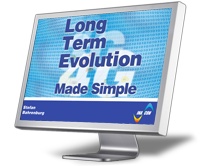 LTE Made Simple (German Version)
LTE Made Simple (German Version)
WBT Beschreibung

- Das Web Based Training ist für alle, die die Technologie und die Konzepte von LTE, sowie die künftigen 4G-Standards von 3GPP verstehen müssen.
- Nach der allgemeinen Einführung in den 4G-Standard, beginnt das Web Based Training mit einer Einführung der Voraussetzungen von LTE.
- Der folgende Teil stellt die wichtigen Merkmale der Layer 1 Schlüssel-Technologie dar: OFDM und MIMO.
- Das Web Based Training geht mit einer Beschreibung des LTE-L1 weiter. Unter anderem betrachten wir im Einzelnen die Anwendung von grundlegenden Technologien wie OFDMA für den Downlink und SC-FDMA für den Uplink in LTE sowie die LTE-Frame-Struktur.
- Dieser Teil endet mit der Erörterung der Physical Layer Prozeduren.
- Das nächste Kapitel beschreibt im Detail die oberen Protokoll-Ebenen von E-UTRAN.
- Dieses Kapitel präsentiert die Initial Context Setup-Prozedur von LTE und beschreibt den Datenfluss eines TCP / IP-Pakets durch die Protokollschichten.
 Einige Ihrer Fragen, die beantwortet werden
Einige Ihrer Fragen, die beantwortet werden
- Was ist LTE und warum wird es in erster Linie eingeführt ?
- Was sind die Anforderungen an LTE und wie unterscheiden sie sich von denen von UMTS?
- Was sind die wichtigsten Merkmale von LTE's (E-UTRAN's) Layer 1 und Layer 2 / 3?
- Wie entwickelt sich das LTE und SAE (System Architecture Evolution) aus dem Mobile Radio Network?
- Wie arbeiten die grundlegenden Physical Layer Technologien von LTE wie OFDM und MIMO?
- Wie ermöglicht die Physical Frame Struktur die Verwendung einer flexiblen Bandbreiten-Zuweisung?
- Wie arbeiten die Physical Layer Prozeduren in LTE?
- Wie kann der Durchsatz der UE Kategorien berechnet werden?
- Was sind die Aufgaben der höheren Protokoll-Ebenen und die Funktionen der eNode B: MAC, RLC, PDCP und RRC?
- Wie bewegen sich die TCP-Pakete im einzelnen durch die Protokollschichten?
 WBT Dauer
WBT Dauer
- ca. 3 Stunden
 Detaillierter Inhalt
Detaillierter Inhalt
Part 1: Principles and Motivation of LTE
- Overview and Outlook of the technical Evolution
- Performance and Mobility Management related Issues
- Architecture related Issues
- Procedure and Radio related Issues
- Quiz 1: Mobile Radio Comparison
- Requirements on LTE
- AIPN - What does it mean?
- LTE and System Architecture Evolution (SAE)
- The Control Plane Protocol Stack
- The User Plane Protocol Stack
- X2 Interface Control Plane Protocol Stack
- X2 Interface User Plane Protocol Stack
- Channel Types
- Quiz 2: E-UTRAN Protocol Stack and Channel Overview
Part 2: Key Technologies of the LTE Physical Layer
- Introduction of OFDM Technology
- OFDM Principle and Example
- OFDM versus OFDMA
- OFDM versus OFDMA continued
- LTE Modulation schemes
- OFDM Issues and Solutions
- ... and the solution in OFDM: Cyclic Prefix
- Quiz 3: OFDM and Modulation
- The Basic Problems: Signal Fading Physics between TX and RX
- Possible Solutions: Smart Antenna Technologies
- MIMO Principle Operation
- Quiz 4: MIMO Principles
Part 3: The Physical Layer of E-UTRAN
- Logical Channels in E-UTRAN
- Transport Channels in E-UTRAN
- Physical Channels in E-UTRAN
- Uplink Direction - UE to eNB
- Downlink Direction - eNB to UE
- Quiz 5: LTE Physical Channel Details
- LTE Frame Structure (FDD)
- Resource Block and Resource Element Definition
- Overview of Important Identifiers in LTE
- Quiz 6: Frames and Identifiers
- Overview of Physical Layer Procedures
- Random Access Principle
- LTE Random Access Procedure
- UE Classes
- Quiz 7: Physical Layer Procedures and UE Classes
Part 4: The Higher Layers of E-UTRAN
- Features of the MAC Layer
- Features of the RLC Layer
- Features of the PDCP Layer
- Features of the RRC Layer
- RRC State Characteristics
- NAS Protocol States and Transitions
- Quiz 8: Higher Layer Protocols
- LTE and SAE Bearer Architecture and Relationships
- The QoS-Profile of the LTE / SAE-Bearer
- QoS Classes Identifier
- Security in LTE
- Quiz 9: QoS and Security
- The Initial Context Setup Procedure
- The Initial Context Setup Procedure (continued)
- The Initial Context Setup Procedure (continued)
- How a TCP/IP MTU reaches the UE / the Internet
- Quiz 10: Initial Attachment
Demo Version
Bestellung
Product Details:
- 48 Slides
- 10 Quizzes
- Lizenz bis : 20 Aug 2026
- Preis: 169.- €
v1.000
ℹ️ Try out the updated search below!
Search:
Demo Version
Are You Curious?
If you interested in our Web Based Trainings, please contact us. We would be pleased to inform you.Our Web Based Trainings
We are proud to introduce the first INACON Web Based Trainings:
Our Advantages
Technology in 3 Hours
Expert Trainers
Audio + Video ...
Advanced Didactics
CBT vs. WBT
